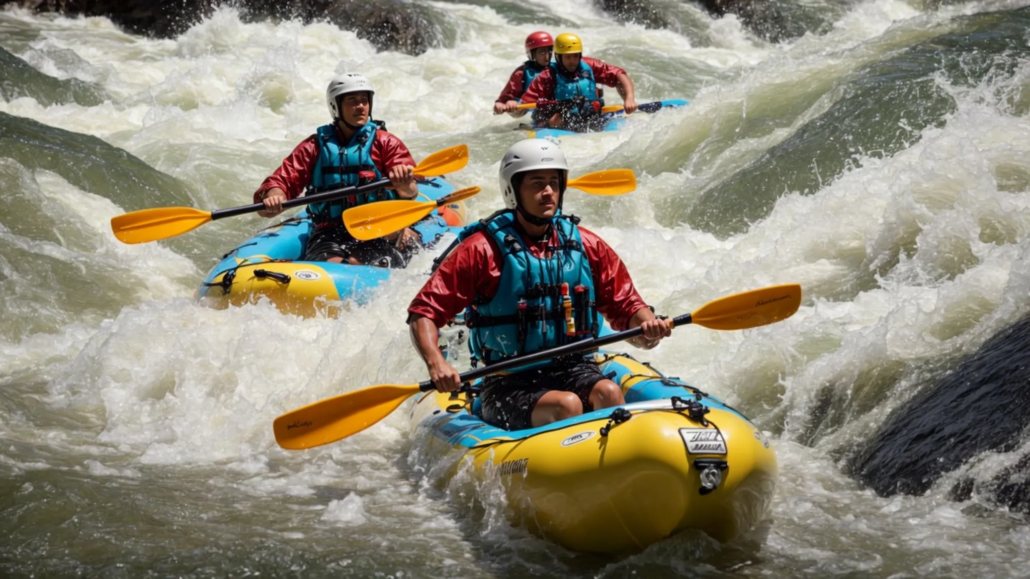Exploring the Rich History of Ocoee River White Water Rafting
Nestled within the rugged landscapes of East Tennessee, the Ocoee River has long been a pulsating artery of adventure for thrill-seekers and nature enthusiasts alike.
From its thunderous rapids to the serene beauty that envelopes its banks, this river’s journey from a hidden gem to an internationally recognized whitewater rafting destination is as riveting as navigating its waters.
With a rich tapestry woven from historical milestones and the natural ballet of water against rock, the story of white water rafting on the Ocoee River is one of resilience, passion, and the relentless call of the wild.
Revel in the tales of how floods, dams, and the spirit of the river itself shaped the course of aquatic adventures.
Keep reading to unlock the untold narratives and secrets that the Ocoee River holds within its currents.
The Birth of White Water Rafting on the Ocoee River
Embarking on a journey down the Ocoee River not only thrills with its whitecaps and rapids but also traverses through layers of American history, echoing tales from the days when Cherokee tribes governed the land to the moment the river transformed into a beacon for outdoor enthusiasts.
This waterway, cutting through the bedrock of East Tennessee, has undergone a remarkable metamorphosis.
Initially, the lifeline for early settlers and later a powerhouse for logging operations, its whispering waters hold stories of change and resilience.
Ignited in the 1970s, a surge in public interest for recreation flipped the script for the Ocoee.
What was once a river harnessed for its resources and controlled by dams built by the Tennessee Valley Authority, swung open its gates to adventure-seekers, marking the beginning of an era where the roar of the rapids called louder than the hum of machinery.
This era not only turned the serene flows and the surrounding Cherokee National Forest into a playground for rafters and history enthusiasts but also set the stage for the Ocoee to etch its mark globally as a premier destination for whitewater activities.
Tracing Back to the Cherokee and Early Settlers
The verdant banks and swirling currents of the Ocoee River played host to the storied past of the Cherokee people long before rafters and kayakers carved through its waters. These indigenous residents hunted, fished, and lived in harmony with this tumultuous river, a sacred thread in the fabric of their rich culture and daily survival.
Years later, as settlers pushed into the heart of East Tennessee, drawn by the promise of new beginnings, the Ocoee’s role evolved significantly. It became a vital conduit for commerce and communication, marking a pivotal shift in the relationship between humans and this dynamic waterway, setting a foundational piece for the future of Ocoee river rafting.
The 1970s Boom: From Logging River to Rafters’ Paradise
The 1970s introduced a transformative chapter in the Ocoee River’s tale, shifting its identity from a resourceful logging channel to a magnet for white water enthusiasts. An abrupt increase in public interest for outdoor recreation, paired with a newfound appreciation for the natural world, steered the Ocoee’s fate towards becoming a rafter’s haven.
As the decade saw a rise in environmental awareness, the Ocoee, with its challenging rapids and breathtaking scenery, emerged as a prime location for white water rafting. This period didn’t just change the river’s usage; it redefined the entire region as a destination for thrill-seekers and nature lovers alike, laying the groundwork for the river’s future as a celebrated site for adventure and recreation.
Milestone Events in Ocoee Rafting History
Navigating through the energetic currents of the Ocoee River’s history, several pivotal moments stand out, driving the evolution of rafting on this spirited waterway.
Among these, the spotlight of the 1996 Olympics shines brightest, propelling the Ocoee into a global arena and setting a precedent for environmental stewardship and the careful management of rafting activities.
This era not only underscored the river’s capacity for world-class sporting events but also catalyzed efforts to balance the thrill of white water rafting with the imperative of preserving the river’s natural beauty and health for generations to come.
The 1996 Olympics and Global Spotlight
The watershed moment in Ocoee River rafting history undeniably sparkled during the 1996 Summer Olympics, a time when the Ocoee Whitewater Center took center stage, hosting the canoe slalom events. This spotlight introduced the world to the roaring currents and thrilling rapids of the Ocoee, placing it on the map as a mecca for whitewater enthusiasts and firmly establishing its status as a premier destination for adventure sports.
Quickly, the river transformed from a regional treasure into a global phenomenon, drawing visitors and athletes from across the globe to East Tennessee. The inclusion in the Olympics didn’t just amplify the Ocoee River’s appeal; it underscored its capabilities to host world-class whitewater rafting competitions, creating a legacy that continues to influence the river’s stewardship and recreational offerings to this day.
Environmental Conservation Efforts and Rafting Regulations
As the popularity of white water rafting on the Ocoee River surged, so did the awareness of its environmental impact, leading to significant conservation efforts. The Tennessee Valley Authority, along with local outfitters and environmental groups, championed initiatives to minimize ecological footprints, ensuring the river’s rapids and wildlife thrived amidst the adrenaline-fueled adventure. These collaborative actions underscored the balance between the excitement of rafting and the imperative of preserving the natural elegance of the Ocoee River.
Regulating the rhythmic flow of rafters along the Ocoee didn’t just aim to protect the river’s ecosystem; it also sought to optimize the rafting experience. Stricter rafting regulations were introduced, including specific season dates and water flow levels, managed meticulously by the dam releases. By implementing these measures, authorities ensured that the thrill of navigating the Ocoee’s rapids could be enjoyed not only by current enthusiasts but by future generations, all while safeguarding the river’s health and vitality.
Navigating the Rapids: Classifying Ocoee’s Challenges
Embarking on a journey down the Ocoee River, the classification of rapids from the gentle sweeps of Class I to the heart-pounding drops of Class V offers an exhilarating testament to the river’s diverse challenges.
Among these, Grumpy’s and Hell’s Hole stand out as legendary, presenting rafters with an unforgettable dance across the river’s wild heart.
This spectrum of rapids not only categorizes the level of expertise required to navigate them but also underscores the river’s rich tapestry of natural obstacles that have drawn adventurers from around the globe.
As we delve deeper, understanding these classifications becomes essential in appreciating the full spectrum of experiences the Ocoee offers, painting a vivid picture of the thrills that lie in wait.
Understanding Rapid Classification From I to V
Grasping the concept of rapid classification can transform a white water adventure from simply exhilarating to profoundly understanding nature’s might. These classifications, ranging from Class I to V, act like a language – a code that deciphers the river’s moods and challenges, providing crucial information for anyone navigating its course.
Delving into this system, Class I represents the easiest, where waters are more akin to a gentle push rather than a fierce battle, suitable for beginners or those seeking a more serene connection with the river. Moving towards Class V, the intensity and technicality heighten, presenting obstinate challenges that demand respect, skill, and a deep bond with the pulsating heart of the Ocoee.
Highlighting Notorious Rapids Like Grumpy’s and Hell’s Hole
I’ve had the privilege of navigating the notorious rapids of Grumpy’s and Hell’s Hole, challenges that stand as testaments to the Ocoee River’s wild spirit. Grumpy’s, with its deceptive calm leading to an abrupt plunge, demands precision and boldness from rafters, offering a thrilling ride that etches into the memory of those daring enough to take it on.
Hell’s Hole, equally formidable, presents a tumultuous journey through churning waters that seem to defy gravity. Mastering this rapid feels like a rite of passage, a moment where skill and river’s roar meet in a dance that few other experiences can match. These rapids not just test your mettle but also deepen your respect for the river’s power and beauty.
Seasons of the Ocoee River – When Is Best to Raft?
Deciding when to challenge the Ocoee River’s rapids can significantly impact your rafting experience. Spring unveils the river’s wild side, with snowmelt and rain swelling the waters, making it an adventurous time for those seeking robust rapids and cooler weather.
Summer brings a steady flow of whitewater enthusiasts, drawn by warmer temperatures and the Tennessee Valley Authority’s reliable dam release schedule. This season offers an ideal setting for families and first-timers, with the sun sparkling off inviting waves and outfitters bustling with activity.
Autumn wraps the Ocoee valley in a brilliant display of colors, creating a breathtaking backdrop for rafting adventures. Lower water levels during this season challenge seasoned rafters with more technical navigation, adding a layer of complexity to the river’s ever-changing character.
Winter, though quieter, holds its charm for the hardiest of adventurers, ready to brave the chill for a more solitary experience on the river. While many outfitters close, the undisturbed peace of the Ocoee during this time offers a unique perspective on its timeless beauty and resilience.
Conclusion
Exploring the rich history of Ocoee River white water rafting reveals the river’s transformative journey from a vital resource for Cherokee tribes and early settlers, to a logging channel, and finally into a premier destination for outdoor enthusiasts.
The 1970s ignited a shift towards recreational use, marking the Ocoee’s renaissance as a white water haven, further amplified by its spotlight during the 1996 Olympics.
This period not only introduced the Ocoee to the world but also underscored the importance of balancing thrilling rafting experiences with environmental conservation efforts.
The river’s notorious rapids, like Grumpy’s and Hell’s Hole, challenge and allure rafters, epitomizing the river’s wild spirit.
Understanding the history of the Ocoee River enriches the rafting experience, highlighting the importance of preserving its natural beauty and vitality for future generations, all while enjoying the thrills it offers across different seasons.


